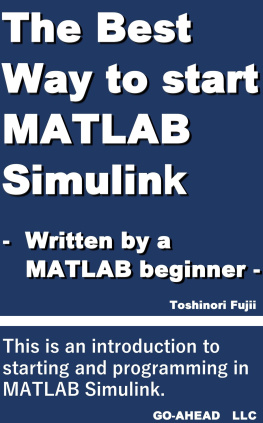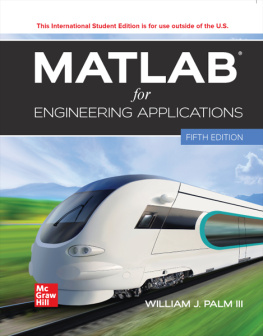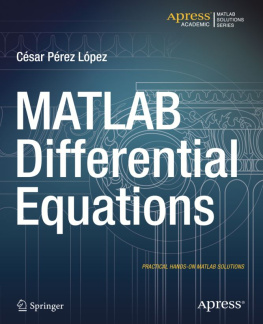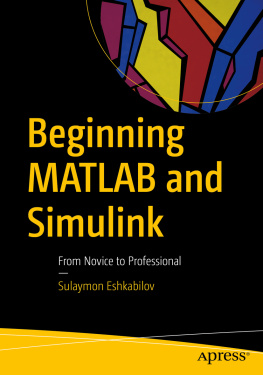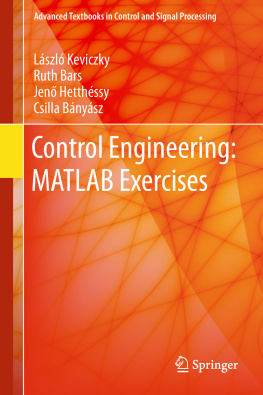Yeo Yeong-Koo - Chemical Engineering Computation with MATLAB®
Here you can read online Yeo Yeong-Koo - Chemical Engineering Computation with MATLAB® full text of the book (entire story) in english for free. Download pdf and epub, get meaning, cover and reviews about this ebook. year: 2021, publisher: Taylor & Francis Group, genre: Home and family. Description of the work, (preface) as well as reviews are available. Best literature library LitArk.com created for fans of good reading and offers a wide selection of genres:
Romance novel
Science fiction
Adventure
Detective
Science
History
Home and family
Prose
Art
Politics
Computer
Non-fiction
Religion
Business
Children
Humor
Choose a favorite category and find really read worthwhile books. Enjoy immersion in the world of imagination, feel the emotions of the characters or learn something new for yourself, make an fascinating discovery.

- Book:Chemical Engineering Computation with MATLAB®
- Author:
- Publisher:Taylor & Francis Group
- Genre:
- Year:2021
- Rating:5 / 5
- Favourites:Add to favourites
- Your mark:
- 100
- 1
- 2
- 3
- 4
- 5
Chemical Engineering Computation with MATLAB®: summary, description and annotation
We offer to read an annotation, description, summary or preface (depends on what the author of the book "Chemical Engineering Computation with MATLAB®" wrote himself). If you haven't found the necessary information about the book — write in the comments, we will try to find it.
Chemical Engineering Computation with MATLAB® — read online for free the complete book (whole text) full work
Below is the text of the book, divided by pages. System saving the place of the last page read, allows you to conveniently read the book "Chemical Engineering Computation with MATLAB®" online for free, without having to search again every time where you left off. Put a bookmark, and you can go to the page where you finished reading at any time.
Font size:
Interval:
Bookmark:
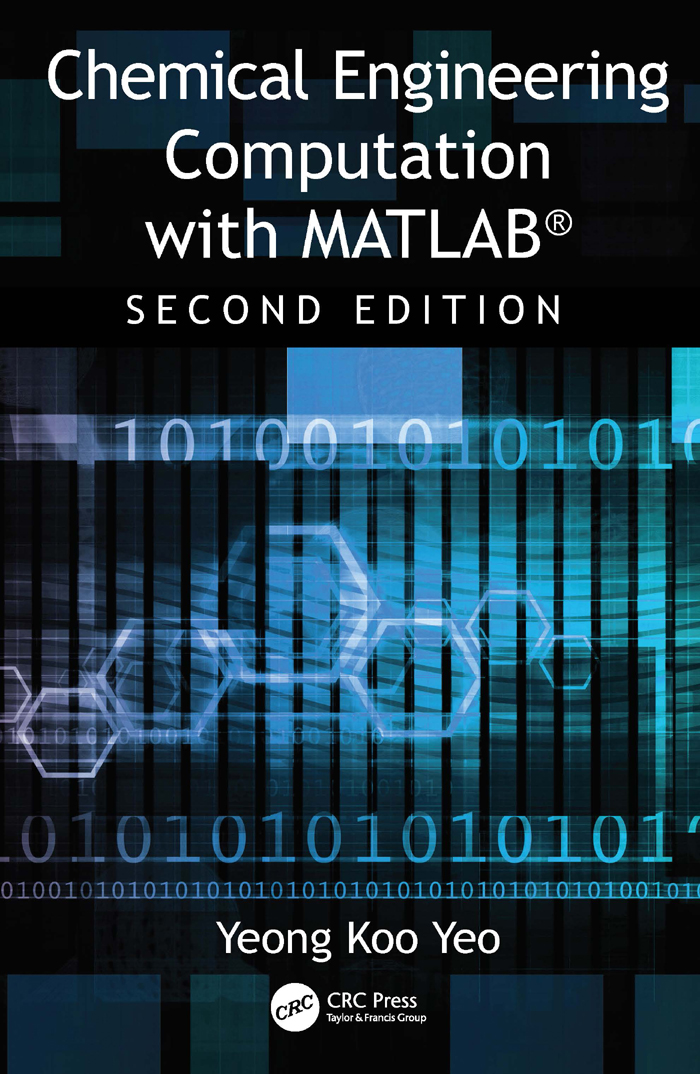
CHEMICAL ENGINEERING COMPUTATION WITH MATLAB
Yeong Koo Yeo

CHEMICAL ENGINEERING COMPUTATION WITH MATLAB
MATLAB is a trademark of The MathWorks, Inc. and is used with permission. The MathWorks does not warrant the accuracy of the text or exercises in this book. This books use or discussion of MATLAB software or related products does not constitute endorsement or sponsorship by The MathWorks of a particular pedagogical approach or particular use of the MATLAB software.
Second edition published 2021
by CRC Press
6000 Broken Sound Parkway NW, Suite 300, Boca Raton, FL 33487-2742
and by CRC Press
2 Park Square, Milton Park, Abingdon, Oxon, OX14 4RN
2021 Taylor & Francis Group, LLC
First edition published by CRC Press 2017
CRC Press is an imprint of Taylor & Francis Group, LLC
Reasonable efforts have been made to publish reliable data and information, but the author and publisher cannot assume responsibility for the validity of all materials or the consequences of their use. The authors and publishers have attempted to trace the copyright holders of all material reproduced in this publication and apologize to copyright holders if permission to publish in this form has not been obtained. If any copyright material has not been acknowledged, please write and let us know so we may rectify in any future reprint.
Except as permitted under U.S. copyright law, no part of this book may be reprinted, reproduced, transmitted, or utilized in any form by any electronic, mechanical, or other means, now known or hereafter invented, including photocopying, microfilming, and recording, or in any information storage or retrieval system, without written permission from the publishers.
For permission to photocopy or use material electronically from this work, access
Trademark notice: Product or corporate names may be trademarks or registered trademarks, and are used only for identification and explanation without intent to infringe.
Library of Congress Cataloging-in-Publication Data
Names: Yeo, Yeong-Koo, author.
Title: Chemical engineering computation with MATLAB / by Yeong Koo Yeo.
Description: Second edition. | Boca Raton, FL : CRC Press/Taylor & Francis Group, LLC, [2021] | Includes bibliographical references and index. |
Summary: This new edition continues to present basic to advanced levels of problem-solving techniques using MATLAB. It provides even more examples and problems extracted from core chemical engineering subject areas and all code is updated to MATLAB version 2020. It also includes a new chapter on computational intelligence. This essential textbook readies engineering students, researchers, and professionals to be proficient in the use of MATLAB to solve sophisticated real-world problems within the interdisciplinary field of chemical engineering-- Provided by publisher.
Identifiers: LCCN 2020043323 (print) | LCCN 2020043324 (ebook) | ISBN
9780367547820 (hardback) | ISBN 9780367547844 (pbk) | ISBN 9781003090601 (ebook)
Subjects: LCSH: Chemical engineering--Data processing. | MATLAB.
Classification: LCC TP184 .Y46 2021 (print) | LCC TP184 (ebook) | DDC
660.0285--dc23
LC record available at https://lccn.loc.gov/2020043323
LC ebook record available at https://lccn.loc.gov/2020043324
ISBN: 978-0-367-54782-0 (hbk)
ISBN: 978-1-003-09060-1 (ebk)
Typeset in Times
by MPS Limited, Dehradun
Access the Support Materials: https://www.routledge.com/9780367547820
This book focuses on the presentation of problem-solving techniques in the main subject areas of chemical engineering. Basics to advanced levels of problem solving are covered utilizing MATLAB, which is a high-performance language for technical computing. This book provides numerous examples and exercises, as well as extensive problem-solving instruction and solutions, for various chemical engineering problems. Solutions are developed using fundamental principles to construct mathematical models, and an equation-oriented approach is used to generate numerical results. For efficient problem solving, various numerical methodsincluding linear and nonlinear algebraic equations, finite difference methods, ordinary differential equations, boundary-value problems, partial differential equations, curve fitting, and linear and nonlinear regressionsare employed in the examples.
Most problems encountered in chemical engineering are very sophisticated and interdisciplinary. Thus, calculations for chemical engineering problem solving by portable calculators or hand calculations are limited to only a few simple applications and problems. Since the introduction of personal computers and mathematical software packages in the early 1980s, emphasis has gradually shifted to computer-based problem solving. It is increasingly becoming important for todays engineering students, researchers, and professionals to be proficient in the use of software tools for problem solving.
MATLAB is one such tool that has been found suitable for implementing algorithms required in engineering education, graduate research, advanced mathematics, and industrial operation-aid systems. It is distinguished by its ability to perform calculations in vector-matrix form, a large library of built-in functions, strong structural language, and a rich set of graphical visualization tools. Furthermore, MATLAB integrates computations, visualization, and programming in an intuitive, user-friendly environment. These useful features of MATLAB can be effectively applied in chemical engineering problem-solving activities. Examples and problems introduced in this book demonstrate how some of these special capabilities of MATLAB can be best used for effective and efficient problem solving.
This book is designed for chemical engineering students and industrial professionals. MATLAB is adopted as the computation environment throughout this book. This book provides examples and problems extracted from core chemical engineering subject areas and presents a basic instruction in the use of MATLAB for problem solving. Emphasis is placed on setting up problems systematically and obtaining required solutions efficiently. Additionally, since this book presents examples and problems commonly encountered in most chemical engineering subject areas, it can serve as a reference in various scenarios and environments. Since all examples and problems presented in this book are solved with MATLAB, this book can also be a resource in developing proficiency in the use and application of MATLAB. Practicing engineers and students alike can learn to write MATLAB programs for various chemical engineering applications.
Examples presented in this book demonstrate the implementation of various problem-solving approaches and methodologies for problem formulation, problem solving, analysis, and presentationas well as visualization and documentation of results. This book also provides aid with advanced problems that are often encountered in graduate research and industrial operations, such as nonlinear regression, parameter estimation in differential systems, two-point boundary-value problems, and partial differential equations and optimization.
This book is intended for those with interest in learning how to use MATLAB to solve chemical engineering problems using computers. It can be used as a textbook in a one-semester course for students in chemical engineering and related disciplines. For undergraduate students, this book can be a resource for learning how to classify and analyze problems according to the numerical methods that facilitate efficient and effective computations. It can also be utilized as a reference for chemical engineering researchers and engineers, particularly in computer-aided problem solving.
Font size:
Interval:
Bookmark:
Similar books «Chemical Engineering Computation with MATLAB®»
Look at similar books to Chemical Engineering Computation with MATLAB®. We have selected literature similar in name and meaning in the hope of providing readers with more options to find new, interesting, not yet read works.
Discussion, reviews of the book Chemical Engineering Computation with MATLAB® and just readers' own opinions. Leave your comments, write what you think about the work, its meaning or the main characters. Specify what exactly you liked and what you didn't like, and why you think so.

